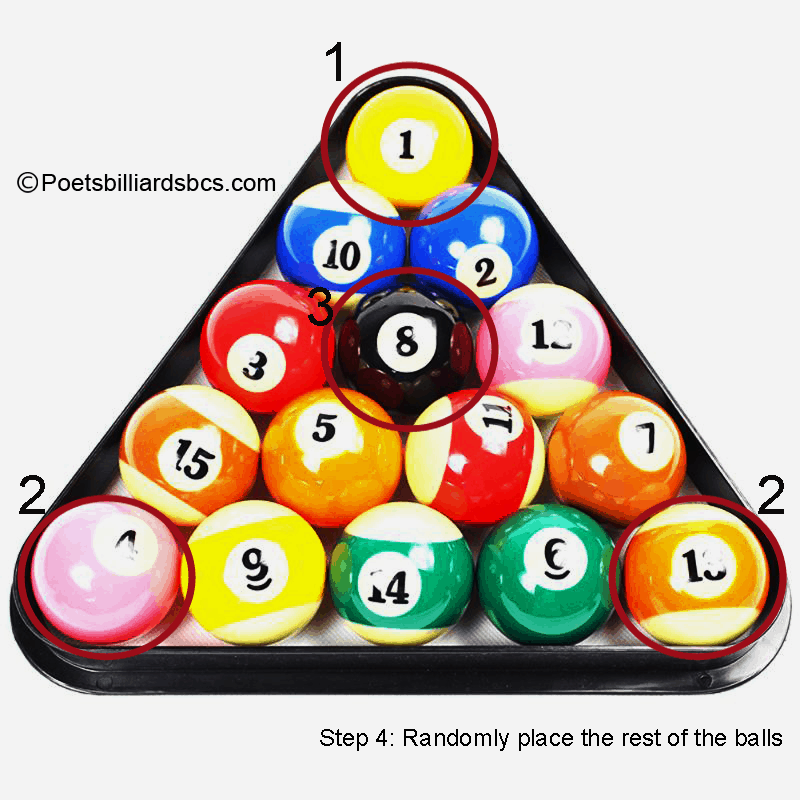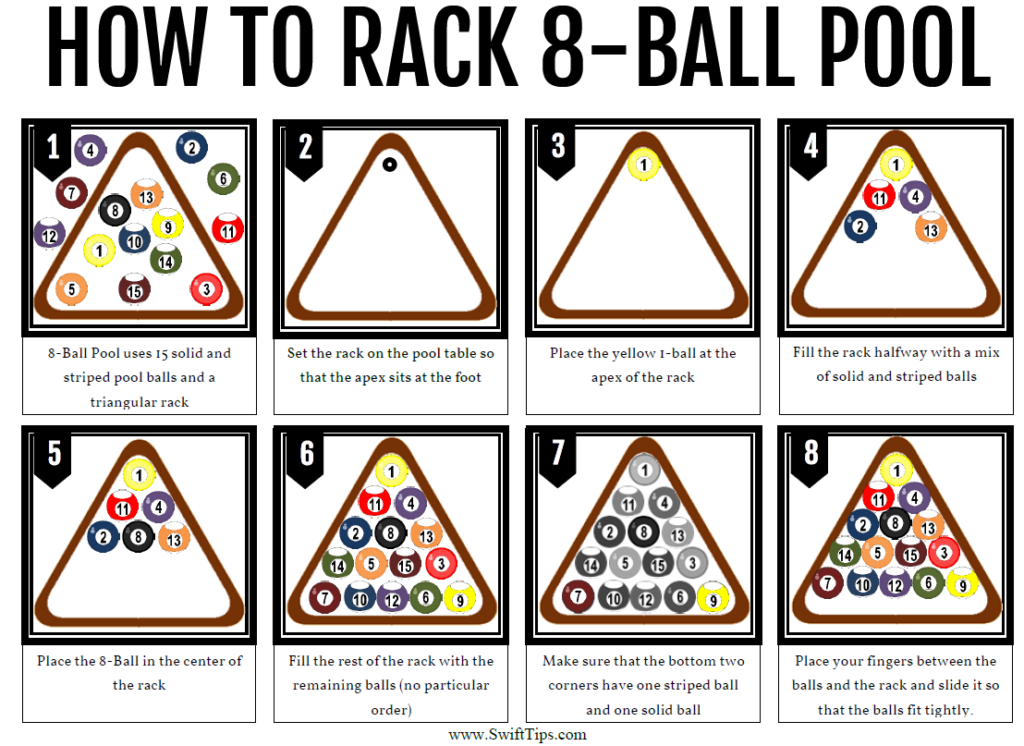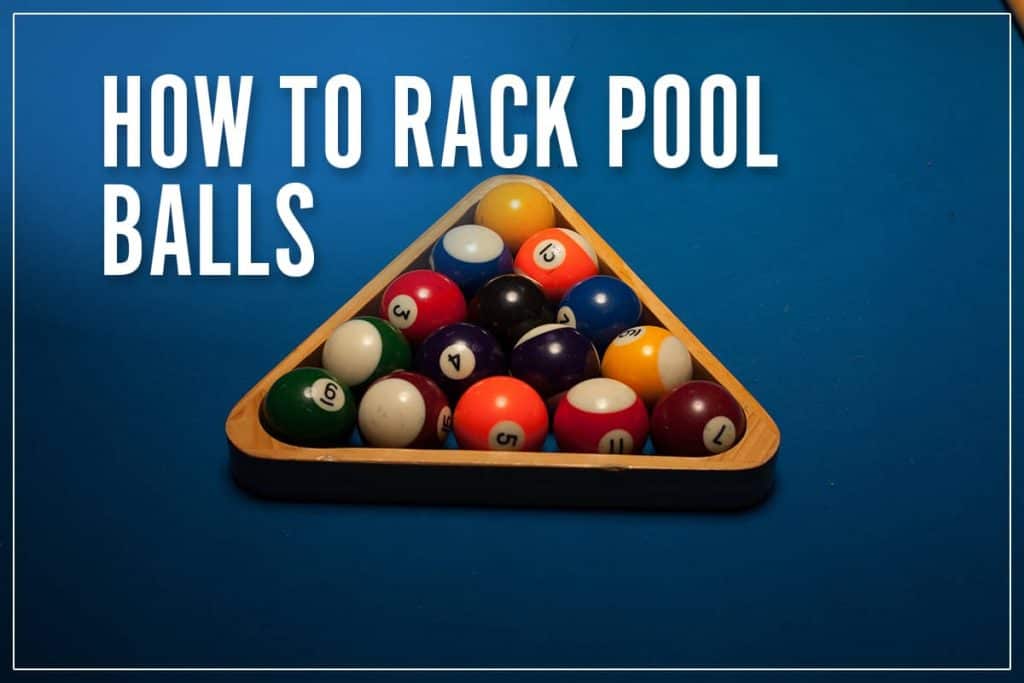Learn How To Rack Billiard Balls: Expert Tips & Tricks
Is mastering the art of the pool table rack truly as simple as it seems? The seemingly straightforward process of arranging billiard balls before a game is, in fact, a crucial determinant of a successful break and, ultimately, the outcome of the game.
Racking, in its essence, is the act of precisely positioning the fifteen billiard balls on the table's felt surface, ready for the break. It is a foundational skill, yet often overlooked, in the pursuit of pool proficiency. The aim isn't just to get the balls in place; its about creating a strategically advantageous configuration that sets the stage for a powerful and, ideally, productive first shot. Properly racked balls contribute significantly to a break that can either scatter the balls perfectly or leave the breaker at a disadvantage.
The process of racking, while seemingly simple, demands attention to detail and understanding of the game's nuances. This is where the magic lies. Different variations of pool, such as Eight-Ball, Nine-Ball, and Straight Pool, employ their own distinct racking styles, dictating both ball placement and the overall strategy. For the novice player, understanding these variations is key, and the journey to master the pool table begins here.
Before diving into the specifics of each game, it's worth examining some general principles that apply across most pool variants. Firstly, the balls should be tightly packed within the rack. A tight rack ensures that the balls are touching each other, maximizing the transfer of energy upon the break, and minimizing the "gaps" that can result in a less effective initial shot. Secondly, the apex ball the ball at the front of the triangle or diamond should be correctly positioned. This is often placed on the foot spot, a crucial point on the table that impacts the break and the subsequent flow of the game.
To excel at racking pool balls and master the art, one should consider the following key elements:
- Apex Ball Placement: Correctly position the apex ball, typically on the foot spot.
- Tight Racking: Ensure the balls are packed together snugly within the rack.
- Manual Locking: If necessary, use your fingers to gently lock the balls in place within the rack.
- Tapping Down: After removing the rack, lightly tap the balls down to maintain their tight formation.
These elements, when applied consistently, can significantly enhance the chances of achieving a successful break. Following these guidelines is critical to ensure that the break isn't a wasted shot and that the breaker begins the game with a strategic advantage. A well-executed break can dictate the course of the game, providing a significant advantage to the player.
The specifics of ball placement vary depending on the particular variant being played. Let's consider the most common formats, starting with the venerable game of Eight-Ball.
In Eight-Ball, the object is to pocket all your assigned balls (solids or stripes) and then legally pocket the 8-ball to win. The rack in Eight-Ball follows a specific pattern, as illustrated below:
In Eight-Ball, the most critical aspect of the rack is the positioning of the 8-ball. This black ball is positioned at the center of the third row. In either corner of the rack should be a solid and a stripe ball. The other balls are placed randomly.
The key to mastering the Eight-Ball rack is understanding the significance of each position. This preparation allows the breaker to strategically scatter the balls and gives the player a distinct advantage at the start of the game. Once this sequence is secured, players fill the rest of the rack with the remaining balls, mixing solids and stripes to ensure a balanced setup. Mastering this basic ball placement ensures the beginning of a good game.
Rotation pool represents another prominent form of billiard game. In rotation, the goal is to pocket the balls in numerical order, starting with the 1-ball. To rack for Rotation, follow these steps:
- Use a Standard Triangle Rack: Ensure that you have a standard triangle rack that accommodates all fifteen balls.
- Apex Ball Placement: Position the 1-ball at the apex of the triangle, on the foot spot.
- Fill Out the Corners: Place a 2-ball and a 3-ball in the bottom corners of the rack.
- Fill Out Remaining Spaces: The remaining balls are placed in any order.
Straight Pool, also known as 14.1 continuous, is a more strategic and demanding game, where the player must call the ball and pocket it in a specific pocket to score points. The game is won by the player who reaches the pre-determined score. The racking technique in Straight Pool is unique, and it doesn't depend on any specific order because of the random nature of the balls that remain on the table at the end of the game.
The process of racking in Straight Pool is as follows:
- Full Rack: Place all fifteen balls into the rack.
- No Specific Order: Since balls are potted randomly, there are no rules for ball order.
These subtle differences in racking techniques and the specifics involved underscore the importance of understanding the rules of each game and how they contribute to the overall strategy. Regardless of the pool variant, the aim remains the same: to create a rack that sets the stage for a powerful, well-placed break.
Whether you are new to the game or a seasoned player, learning how to rack pool balls correctly is essential. The method is simple, yet the impact on the game is substantial. A properly executed rack sets the foundation for a successful break and, ultimately, a more engaging and strategically rewarding game. To effectively rack pool balls, make use of the standard triangle rack. Then, be sure that all balls are tightly packed. It is also a good practice to manually lock the balls in, and tap them down slightly using a cue ball or another pool ball after removing the rack. By following these steps, you are well on your way to a professional-level rack.
Now, let's turn our attention to those crucial steps that contribute to mastering the art of racking pool balls. These fundamental techniques, when consistently applied, elevate your game and add another dimension to the strategic depth of the sport.
The initial point to consider is the choice of rack. For the majority of pool games, a standard triangle rack is indispensable. This tool establishes a uniform configuration, ensuring that each break begins with the same setup. Proper use of the rack requires precision and patience. Place the apex of the rack on the foot spot. Ensure that the balls are tightly packed together inside the rack. A tightly packed rack guarantees the efficient transmission of force from the cue ball during the break, setting the stage for a productive and powerful initial shot.
Another pivotal step involves the placement of the apex ball. This ball, located at the front of the triangle, has a crucial role in the break. In most formats, the apex ball is positioned on the foot spot, a specific marking on the table. This placement impacts the break and the resulting ball spread. Therefore, maintaining precision when placing the apex ball is vital for setting up a productive break.
Ensuring that all balls are touching is fundamental to a successful rack. The objective is to prevent any gaps or spaces between the balls within the rack. This tight configuration allows the balls to transfer energy efficiently upon contact. As the break begins, the close proximity maximizes the likelihood of an effective scatter, giving the player a competitive advantage from the outset.
The art of racking extends beyond mere ball placement and includes understanding the significance of each ball and their corresponding positions. Once the rack is in place, it's time to fill the remaining spaces in the rack, arranging the balls according to the rules of the particular pool game you are playing. This careful arrangement establishes the foundations for a strategic break, setting the stage for a successful and rewarding game.
While the placement of the apex ball, the tight packing, and the strategic positioning of the balls within the rack remain important, the final step involves the removal of the rack. To ensure that the arrangement of the balls is maintained once the rack is removed, consider these techniques:
- Sliding the Rack: Before the break, carefully slide the rack along the table, making sure the balls remain in their positions.
- Manual Locking: Using your fingers, gently lock the balls in place within the rack.
- Tapping Down: Lightly tap the balls down with a cue ball or another pool ball after removing the rack.
These techniques collectively ensure the balls are tightly arranged after removing the rack, thus maintaining a compact triangle formation. This ensures a strong and predictable break.
Mastering the art of racking is a blend of fundamental skills and strategic thinking. It's a practice that elevates the game, allowing you to have a more engaging and enjoyable experience. Whether playing casually or participating in competitions, learning the right racking methods is essential. By practicing these methods and honing your technique, you can enhance your breaking abilities and improve your overall gameplay.
Ultimately, the success of your break can depend on many factors: your cue ball's placement, the force you apply, and the angle of your shot. However, the most important thing is the quality of the rack itself. By following the techniques and applying the principles described, you will have a well-structured start to the game.
So, the next time you step up to a pool table, remember that success starts with the art of the rack. By paying careful attention to the details, you can increase your chances of having a good break. Then, set yourself up for a successful game.
| Key Aspect | Description |
|---|---|
| Apex Ball Placement | The apex ball is generally placed on the foot spot. |
| Tight Racking | Balls should be packed tightly together, touching each other. |
| Manual Locking | Use fingers to gently lock balls in the rack if needed. |
| Tapping Down | After removing the rack, lightly tap the balls down to maintain tightness. |
| Eight-Ball Rack | 8-ball in the center, solids and stripes in the corners, other balls random. |
| Rotation Rack | 1-ball at the apex, 2 and 3-balls in corners, remaining balls placed randomly. |
| Straight Pool Rack | All 15 balls are placed in the rack; there's no specific order. |
| Racking Tools | A standard triangle rack is typically used. |



Detail Author:
- Name : Darlene Corwin
- Email : damian.mills@roberts.com
- Birthdate : 1981-08-28
- Address : 17502 Wyman Villages Bauchberg, AZ 84360-0151
- Phone : (463) 262-4883
- Company : Howe-Metz
- Job : Caption Writer
- Bio : Iusto nemo consequuntur modi voluptas beatae. Ut omnis itaque similique facere totam quos perspiciatis dolor. Doloribus quibusdam ut eaque quia.